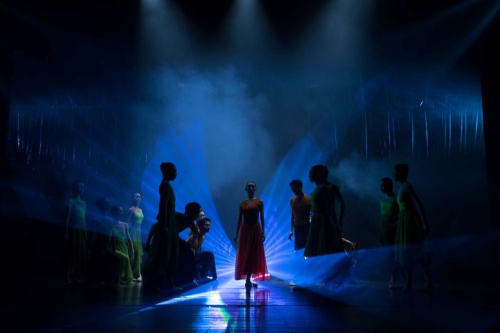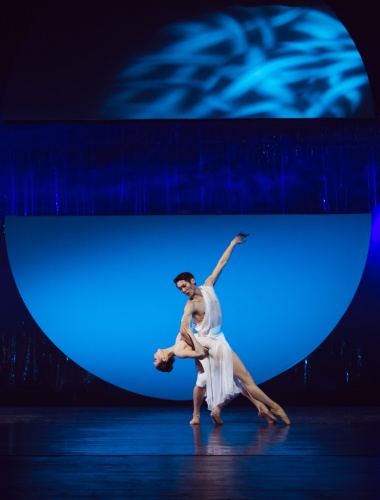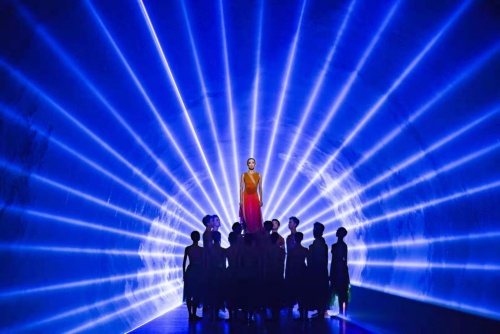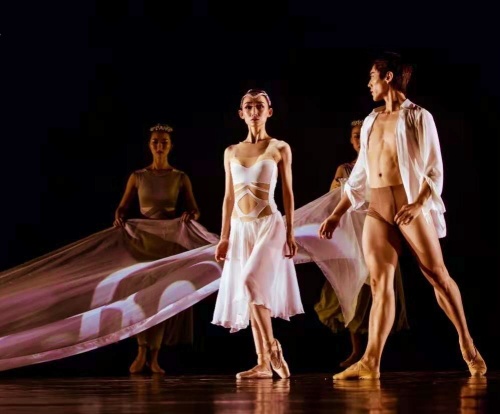|
 |
|
|
 |
 |
With a grand flourish of stunning sets, powerful music and 25 gorgeous dancers, the Guangzhou Ballet of China brought two productions to Lincoln Center (August 17-18) to feast your eyes on. The 30-minute “Goddess of the Luo River” is an ancient Chinese tale, choreographed by Chinese-Canadian Peter Quanz, featuring the exceptional violin concerto of Du Mingxin. The one-hour-plus “Carmina Burana," choreographed by Jiang Qi, transformed Carl Orff’s iconic composition into a powerful contemporary ballet. “Goddess of the Luo River” dates back more than 1,800 years. It is the story of Luo Shen, who drowned when crossing the river and was then transformed into a river deity. Another take, loosely interpreted here, is about a poet (or just a regular Joe), who falls in love with the goddess, but that always turns out badly, as she soars to the heavens, leaving him to wander the banks despondent and alone. The production evoked “Swan Lake” (which the company has performed on other occasions), as the ensemble of fast-moving (but featherless) dancers circled the principal female dancer, danced in lines and spread their wings (metaphorically speaking) across the stage in perfect precision. The principals danced their duets elegantly, but without emotional vibrancy or urgency, which might be the choreographer’s creative choice or cultural reference. The violin composition was exquisitely executed, with slow achingly tender sections and fast rallies, which the ensemble danced at a slower pace than the driving music. The spare-no-expense painted drop cloth sets and lighting by Han Jiang and Chen Ziaji, respectively, made for many ooohs and aaahs, but I still would have cut it down about 10 minutes, 1,800 years notwithstanding. Carl Orff’s magnificent 1936 “Carmina Burana,” set to 24 bawdy, iconoclastic church-bashing Medieval poems, is the backdrop for Jiang’s ambitious three-act ballet replete with love, jealousy, war, destruction and renewal, which melds contemporary Western choreography with a story line that satisfies the East. It opens dramatically with a golden earthy colored cloth filling the stage, the dancers within emerging, as the earth returns to spring awakening. With a huge blue moon backdrop, Helena (Zhou Yu), dressed all in white, walked slowly across the stage, draped in a veil with a lengthy train trailing behind and some atmospheric fog. Bolanzifaluo (Kou Zuquan) wishes to marry her, and in their fine duets, she both embraces and rejects him. In the Second Act, we get the glorification of war. According to the program notes (not always written in the most comprehensible English), “The warriors of war radiate inner strength of the males, who kill bravely on the battlefield, through the conquest of blood and fire.” The bare-chested warriors were dressed in traditional skirts, as they and their fully clothed female counterparts danced carrying green stalks. Later, the men showed off their chops in a tour de force of powerful multiple leaps across the stage. (Throughout the piece, the women also got to express their brilliant balletic mastery, including leaps and turns.) Then there were injured and drunken, maybe dying soldiers, who were either comforted and/or rejected by the women. Somewhere along the way, Helena and Bolanzifaluo were joined by another couple, Kety (Huang Ping) and Crace (Zhang Weiwei), and there was some flirting and change partner and dance routines, so by the end I was confused as to who wound up with whom and why. But it was all good, as the couples danced magnificently together no matter what pairing, but not without the men having a good old-fashioned roust. By the Third Act, the earth is suffering through natural disasters and Bolanzifaluo sacrificed himself. Helena, wearing a red dress, was lifted high up by the ensemble and fell backwards into the group to join her lover and save the earth. “After rain and sunshine, people seem to be reborn, also lamenting the changeability of fate.” The end. The new mythological tale was accompanied by a recording of the magnificent Slovak Philharmonic Chorus CSR Symphony Orchestra (Bratislava), conducted by Stephen Gunzenhauser, which did Orff proud, as did the entire dazzling production.
 Carmina Burana Photo © & courtesy of Photographer Unknown |
|
 Carmina Burana Photo © & courtesy of Photographer Unknown |
|
 Carmina Burana Photo © & courtesy of Photographer Unknown |
|
 Carmina Burana Photo © & courtesy of Photographer Unknown |
|
 Goddess of the Luo River Photo © & courtesy of Photographer Unknown |
|
|
|






